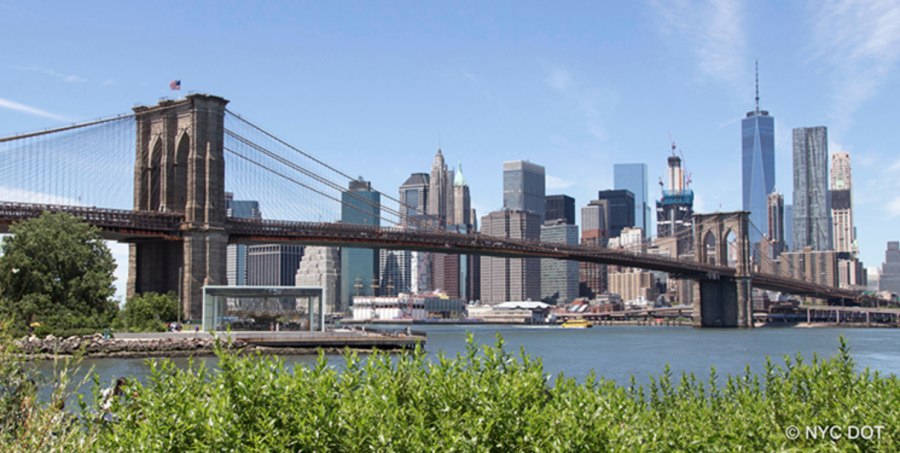The Majestic Brooklyn Bridge
Did you know that everyday, 150,000 vehicles and pedestrians cross the Brooklyn Bridge? Since its opening in 1883, the Brooklyn Bridge has been an essential landmark of New York City. It is considered one of the most important engineering achievements of the 19th century. The story of how the Brooklyn Bridge was built is interesting, yet tragic in some ways.
John Roebling, the designer of the Brooklyn Bridge, was an immigrant from Germany who began building bridges in the United States. By the mid 1800s, he was the most famous bridge builder in the U.S. Roebling began dreaming about building a bridge that would connect Manhattan to Brooklyn in 1857, but the Civil War delayed his dreams. In 1867, the New York state legislator hired a company to build a bridge across the East River. John Roebling was chosen as the chief engineer.
The work of the Brooklyn Bridge began in the summer of 1869. Almost immediately, tragedy struck. John Roebling was on the site and injured his foot in an accident. Shortly after that he died from tetanus. His son Washington Roebling, who had been his partner in building other bridges, and had helped design the Brooklyn Bridge, took over as chief engineer.
At that time, Brooklyn and Manhattan were separate cities. While everybody thought it was a great advantage to connect the two cities, a lot of people thought it was impossible because the East River was so wide. They thought it would be impossible to build a bridge that long. Another problem was that the East River was one of the busiest waterways on earth. The only way that huge boats could go under it was if the Brooklyn Bridge was a high suspension bridge.
Most suspension bridges were made out of iron, but John Roebling’s plan had been to use steel which was stronger. The bridge was designed to have two huge stone towers at either end to support the bridge. Four main cables would come down from the stone towers to support the bridge deck.
Building the Brooklyn Bridge was a very dangerous endeavor. Workers had to excavate deep down into the riverbed in order to achieve a solid foundation for the bridge. To do this they pinned down massive wooden boxes called caissons to the river’s floor using enormous granite blocks. The caissons were airtight chambers and pressurized air was pumped in to keep water and debris out. Workers known as ‘sandhogs’ had to get down to the bottom of the caissons in order to clear away mud and boulders at the bottom of the river. These workers used shovels and dynamite to accomplish this. Some of these workers were immigrants getting paid only $2 a day.
In order to get down into the caissons the workers rode in small iron containers called airlocks. The airlocks were filled with compressed air which allowed the workers to breathe and kept the water out but the air also dissolved a large amount of gasses into the workers’ bloodstreams. When the workers came back to the surface the gasses in the blood were quickly released. This caused a group of symptoms called “caisson disease,” or “the bends.” Symptoms included excruciating joint pain, paralysis, convulsions, numbness, speech impediments and even, in some cases, death. It is believed that more than 100 workers suffered from this disease. Other workers died in accidents such as collapses, explosions and fires. By the early 20th century, scientists finally figured out that the bends could be prevented if the airlocks traveled more slowly to the surface.
During construction, Washington Roebling went into one of the caissons to check on the work being done. He contracted ‘caisson disease’ himself and was partially paralyzed for the rest of his life. His wife, Emily, took charge of the bridge’s construction. Washington Roebling was forced to stay in his house in Brooklyn Heights and watch the construction with a telescope. Emily, who trained herself as an engineer, would take his instructions to the bridge site every day.
The workers reached a depth of 44 ft on the Brooklyn side and 70 ft on the Manhattan side and began filling the caissons with poured concrete. This would support the huge stone towers.
The bridge was completed in 1883. The official grand opening of the Brooklyn Bridge occurred on May 24, 1883. U.S. President Chester A. Arthur came to New York City for the event. The governor of New York, Grover Cleveland, also attended. Thousands of residents from NYC and Brooklyn turned out to witness the ceremony. Marching bands played, cannons fired, and there were a number of speakers who praised the building of the bridge and the increase in commerce it would bring. Emily Roebling was given the first ride across the completed bridge, carrying a rooster in her lap, which was a symbol of victory.
Some people were still worried about the safety of the bridge. On May 17, 1884, P.T. Barnum led 21 elephants across the bridge to prove that it was stable.
The bridge’s construction took 14 years and cost $15 million dollars, which is more than $320 million in today’s dollars. In the decades that followed, the structure of the bridge has been updated to keep pace with the demands of modern traffic. The Brooklyn Bridge was declared a National Historic Landmark in 1964. People still appreciate its beauty, its history and the convenience it provides to commuters.
This is Andrew's first year as a staff writer for Prospect.






